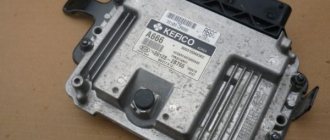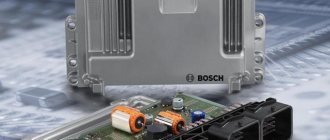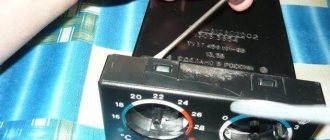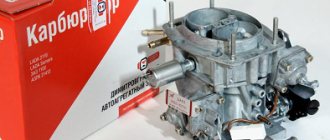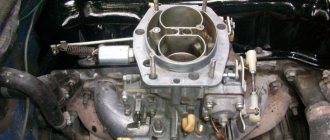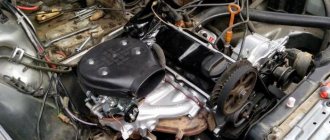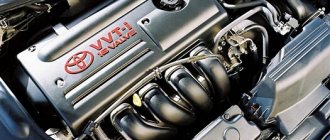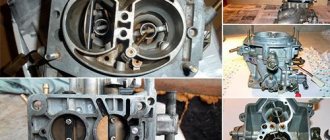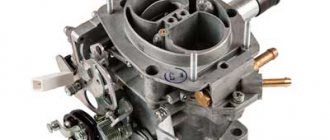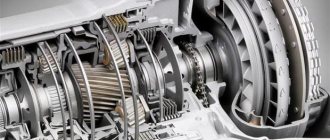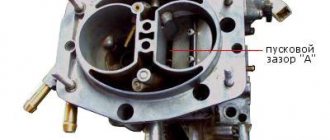Forced idle economizer (EFHH) of Solex carburetor 2108, 21081, 21083
Let's analyze the design and principle of operation of the forced idle economizer (EFS) of carburetors of the Solex family installed on the engines of VAZ 2108, 2109, 21099 cars and their modifications. EPHH is one of the carburetor systems 2108, 21081, 21083 Solex. It is responsible for ensuring that the car engine operates at forced idle.
The forced idle economizer system of the Solex carburetor 2108, 21081, 21083 is designed to cut off the fuel supply through the idle system during engine braking and after turning off the ignition. It provides a reduction in fuel consumption to 0.5 liters per 100 km, prevents the occurrence of diesel ignition (glow ignition), and reduces the emission into the atmosphere of toxic compounds formed when mixture formation deteriorates in the ISF mode.
EPHH Solex device
The carburetor solenoid valve is an actuator of the system that, at the command of the control unit, closes with its needle the hole in the fuel nozzle of the XX system, thereby stopping the fuel supply through it. Installed in the carburetor.
Control unit – the electronic control unit is the control element of the EPHH. It reads the frequency of pulses in the ignition system (via terminal “K” of the ignition coil) and uses them to determine the engine crankshaft speed. In addition, the control unit receives a signal from the contact of the fuel mixture “amount” screw to close or open the throttle valve of the first chamber. At a certain shaft speed and an open throttle signal, it turns off the voltage supply to the solenoid valve, which shuts off the fuel supply through the CXX. The unit is installed on the engine compartment panel next to the ignition system switch.
Contact of the fuel mixture “quantity” screw (sensor-screw) – the tip of the fuel mixture “quantity” screw with the wire attached to it. When the gas pedal is released and the throttle valves are closed, the contact touches the edge of the lever on the throttle valve axis (closed to ground), and a signal is sent to the control unit that the throttle valve is closed.
After pressing the gas pedal, the contact between the tip of the quantity screw and the throttle lever opens (not shorted to ground), and a signal is sent to the control unit that the throttle valve is open. Installed on the carburetor.
visible elements of the EPH system of a Solex carburetor in the engine compartment of a VAZ 21083 car
Operating principle of the forced idle economizer system of a Solex carburetor
The movement of a car by inertia with the gear engaged and the gas pedal released (engine braking) is called forced idling (FID). In this mode, the combustion conditions of the fuel mixture in the engine cylinders sharply worsen, CO and CH emissions increase, and fuel consumption increases. EPHH shuts off the fuel supply in IHH mode to the engine cylinders, thereby optimizing the composition of the fuel mixture and saving fuel.
In this situation, the control unit receives signals from the ground-closed contact on the “quantity” screw that the throttle valve is closed and from the coil about the current crankshaft rotation speed. If the rotation speed is above 2100 rpm, it stops supplying voltage to the output of the carburetor solenoid valve and it will close the opening of the CXX fuel jet. The fuel supply through the idle system will stop. As soon as the crankshaft speed drops to 1900 rpm, the control unit will resume supplying voltage to the solenoid valve. Its needle will retract and open a hole in the CXX fuel jet. The idle system will work.
That is, to forcibly shut off the fuel supply through the idle system, the electronic control unit requires two conditions - a signal about the closed throttle valve and a signal about the engine speed.
Malfunctions in engine operation associated with Solex EPH
— The engine stalls while the car is moving when the gas is released
A similar malfunction can occur if the carburetor idle system is clogged. This must be taken into account when diagnosing EPC faults.
— Dieseling (glow ignition)
The engine runs for some time after the ignition is turned off.
Notes and additions
Forced idle speed (FID) is one of the engine operating modes. Performed while the vehicle is moving with the gear engaged and the gas pedal fully released. For example, when braking with the engine or driving downhill. In this case, the throttle valves of both chambers of the carburetor are completely closed, the engine crankshaft speed is above 1900 rpm. Below 1900 rpm the idle system comes into operation.
Dieseling (glow ignition) - short-term engine operation after turning off the ignition. The fuel entering the engine cylinders under the influence of vacuum from the carburetor is ignited by a heated spark plug, flashes occur in the combustion chambers, moving the pistons. Possible when the EPH system is faulty and “hot” spark plugs are used (plugs with temperature characteristics that do not correspond to this type of engine).
More articles on Solex carburetors
EPHH control unit for Solex carburetor
The Solex carburetor 2108, 21081, 21083 is equipped with an EPHH system (forced idle economizer).
Purpose of the EMK EPHH control unit
The EPHH control unit is designed for timely supply of voltage (switching on) and de-energizing (switching off) the electromagnetic valve (EMV) of the Solex carburetor 2108, 21081, 21083 upon the onset or termination of the forced idling mode of the engine (ISV) - engine braking.
Where is the control unit installed?
The control unit is installed on the engine compartment panel, to the left as the vehicle moves.
The control unit for the forced idle economizer system (ISP) of the Solex carburetor is installed on the engine compartment panel
How does the EMC EPHH control unit work?
To determine the onset of the forced idling mode, the EPHH control unit receives two signals.
— Throttle valves are closed
The signal comes from the screw sensor for adjusting the “amount” of the fuel mixture. Its contact touches the rib of the lever on the throttle valve of the first chamber of the carburetor (“ground”), if it is closed. The contact is fitted with a wire tip that goes to the control unit.
Sensor-screw for adjusting the “amount” of fuel mixture Solex 2108, 21081, 21083
— The crankshaft speed exceeded 2000 rpm
The crankshaft speed signal comes from terminal “K” of the ignition coil (pulses in the ignition system). This is the primary winding of the coil.
Terminal “K” of the ignition coil of the ignition system of VAZ 2108, 2109, 21099 cars
Having received both signals, the control unit de-energizes the carburetor solenoid valve and its needle closes the hole in the CXX fuel nozzle. No fuel flows through the idle system.
Termination of the IAC mode is determined by the block if any of two conditions are not met (either the driver pressed the gas pedal and opened the tip of the screw and the throttle lever, or the engine speed dropped below 1800 rpm). As a result, the control unit resumes the fuel supply through the CXX by applying voltage to the EMC (the EMC pulls the needle inside the housing and opens the CXX fuel nozzle).
Connection diagram for the EPHH Solex control unit
Connection diagram for the control unit of the EPHH system of the Solex carburetor 2108, 21081, 21083
Control unit malfunctions
A faulty EPHH control unit begins to either open or close the valve, regardless of the signals received by it. Jerks and dips appear when the car moves. The engine idling either disappears completely or the engine “troubles”.
To determine the malfunction of the control unit, you can check it (at the same time checking the entire EPH system). You can first check the serviceability of the unit by removing and putting the wire end on the terminal of the carburetor solenoid valve and listening for a click. If there is no click, the EMC does not operate and the unit does not supply voltage to it.
Applicability of the control unit in Solex 2108, 21081, 21083 EPHH systems
TU 37.459.063-84
Notes and additions
The forced idle mode (FID) of a car engine occurs when driving at speed, with the gas pedal released and the gear engaged - coasting (on a flat road or on a descent). In this mode, when the combustion of the fuel mixture in the cylinders deteriorates (the charge density is low, the amount of residual gases is large), it is necessary to turn off the fuel supply to the engine in order to prevent the release of unburned hydrocarbons into the atmosphere and, at the same time, slightly reduce fuel consumption. This is what the EPHH system does with the control unit.
At forced idle, the car moves in the urban cycle 15-20 percent of the time. If the system that ensures its operation is configured correctly and in good working order, then in addition to reducing exhaust emissions, significant fuel savings are obtained.
Twokarburators VK - More information on the topic in our VKontakte group, on Facebook Twokarburators FS , in Odnoklassniki - Twokarburators OK and in Yandex Zen - Twokarburators DZ
More articles on the design of the Solex carburetor 2108, 21081, 21083
— Checking and repairing the EPHH screw sensor (quantity screw) of the Solex carburetor
— Screw for adjusting the throttle position of the second chamber of the Solex carburetor 2108, 21081, 21083
— Screw for adjusting the “quality” of the fuel mixture of the Solex carburetor 2108, 21081, 21083
— Acceleration pump for Solex carburetor 2108, 21081, 21083, device diagram
— Control lever for the air damper of the Solex carburetor 2108, 21081, 21083
— Carburetor engine stalls when releasing gas, reasons
EPHH on VAZ 2109 (carburetor)
Almost all VAZ 2109 cars that have a carburetor in the engine compartment are equipped with economizers. This is the abbreviated name for forced idle economizer or simply EPHH.
The task of the EPHH is as follows:
- Saves fuel in the car;
- Eliminates the supply of fuel to the power unit when the engine is turned off;
- Turns off the fuel supply to the engine through the idle system when the engine is braking.
Checking and repairing the EPH system of carburetor 2108, 21081, 21083 Solex
The forced idle economizer system of the carburetor 2108, 21081, 21083 Solex and its modifications is designed to forcibly shut off the fuel supply to the engine cylinders through the carburetor idle system during engine braking (coasting with the gear engaged and the gas pedal fully released).
It also prevents fuel from entering the engine after it is stopped, thereby preventing it from operating with the ignition off (glow ignition).
Signs of malfunction of the EPH system of carburetors 2108, 21081, 21083 Solex
— No or unstable idle. The engine stalls or runs rough
— The engine stalls in engine braking mode (when coasting with the gear engaged and the gas pedal fully released).
— The engine stalls when the gas is suddenly released at speeds above average (2000 and above) .
— After stopping and turning off the ignition, several flashes occur in the cylinders (dieseling).
Causes of malfunction of the EPH system
— The solenoid valve is faulty. — The solenoid valve control unit is faulty. — The contact of the fuel mixture “amount” screw is oxidized, dirty or damaged. — The connecting wires are damaged or their tips are oxidized. — The connectors of the connecting blocks have come off.
Tools for repair
— Open-end wrench 13 mm. — A piece of wire 0.5 meters. — Tachometer. — Voltmeter. — Ohmmeter.
Or one multimeter or autotester that can work in all these modes.
Checking and repairing the Solex carburetor solenoid valve
1. Remove the wire end from the solenoid valve.
2. Turn on the ignition.
3. Put the wire end back on.
4. You should hear a click when the valve operates.
Operating principle
To determine the cause of the problem and take action to troubleshoot the EPHH, you need to know about the principle of its operation.
- The economizer is equipped with output and input circuits.
- The input circuits are a limit switch and a wire that connects to the switch.
- The throttle (throttle) limit switch tells the economizer whether the gas pedal is depressed or not at that particular moment.
- If the pedal is not depressed, the limit switch closes to ground.
- As soon as the gas pedal is pressed by the driver, the contact is switched off.
- The wire that connects the switch and the economizer reports the number of pulses to the ignition coil. In fact, due to this, the economizer is able to find out about the actual current speed of the power unit.
- The EPHH has only one output circuit - the XX solenoid valve of the carburetor system (XX - idle speed). The economizer can turn this valve on and off.
- Fuel economy is ensured by closing the XX fuel jet at high engine speeds.
- If the gas pedal is not depressed, the throttle limit switch closes to ground, the speed is less than 2.1 thousand per minute, then the economizer opens the XX solenoid valve.
- When the gas pedal is depressed, the limit switch opens, leaving the valve open anyway. The valve closes only when the engine speed exceeds 2.1 thousand per minute.
- The valve is in the closed position until the speed drops below 1.9 thousand per minute.
If the car is coasting with the gear engaged and the accelerator pedal released, the EPHH will not turn on, even if the revolutions drop below 1900 per minute. The economizer monitors the closed position of the damper. If the engine speed at idle is too high, it is perceived as coasting.
Actually, this is all you need to know about the operation of such an element as EPHH.
Practice and research show that the use of an economizer allows you to save about 5 percent of engine consumption.
Symptoms of a problem
There are several main signs indicating failure of the EPHH:
- The engine regularly stalls at idle;
- Detonation occurs in the engine when the ignition is turned off;
- The engine stalls when coasting braking is performed.
You can check whether the EPHH and its control unit are working correctly with your own hands. To check the valve, you should monitor its activation in various operating modes. Correct operation is determined by ear or using a voltmeter.
Symptoms of economizer malfunction
Here is a list of signs that may indicate a malfunction of one of the economizers:
- unstable operation at idle speed;
- difficult starting of a warm engine;
- increased fuel consumption;
- a drop in power and a simultaneous increase in fuel consumption;
- drops of gasoline in the EMR area.
Valve check
There are three main steps to checking the functionality of the solenoid valve.
Verification method
Your actions
Basic operating mode of EPHH
- Start the engine and begin to gradually increase the speed of the power unit;
- Once you cross the 2100 rpm mark, the valve should turn off. This will be heard as a click;
- Now increase the speed to 4000 rpm. In this case, the valve must remain closed;
- Smoothly reduce the speed again, reaching below 1900 rpm. At this moment, the working valve clicks again, which indicates that it is turned on
Engine braking mode
- Disconnect the chip from the damper position limit switch and connect it to ground;
- This action will trick the economizer into telling it that the gas pedal has been released;
- Start the engine and raise the speed above 4000 units per minute;
- Gradually begin to reduce speed;
- When you reach 1900 rpm, the valve should not turn on;
- The limit switch is closed to ground, speeds above idle trigger the engine braking mode. The economizer should not turn on the valve.
Fuel cut-off when ignition is turned off
- Warm up the engine to 90 degrees and turn off the ignition;
- In this case, the engine should stall immediately, not vibrate or rattle;
- If vibrations occur, this indicates that the solenoid valve is not closing the idle jet;
- As a result, gasoline continues to flow into the heated power unit
Device
The VAZ 2109 carburetor consists of two main elements - the body and the cover. All parts are mainly located in the housing (pump, jets, float, etc.). Also, the power system, which may be associated with repairs, includes: candles, EPHH, and so on.
When the pump pumps fuel from the tank, it first enters the carburetor float chamber block. This chamber is also called the first or primary. It serves to maintain an optimal level of gasoline at which the carburetor can operate normally and maintain stable speed. At the entrance to the chamber, there is a special fitting through which fuel passes. Its quantity is controlled by the valve, as well as several floats. When you lightly press the gas pedal, the amount of gasoline entering the chamber, and accordingly its pressure, decreases sharply. In order for the flammable mixture to enter the chamber normally, at low pressure, the valve rises higher, clearing the way. This process is continuous and runs as long as the engine. The valve structure is closely connected to the float. This control scheme eliminates the chance of spark plug overflow.
When you sharply press the gas pedal, a large amount of fuel enters the primary chamber block. In order to protect the candles, there is a secondary chamber. It opens when the engine speed is high. The first chamber, with the accelerated movement of fuel, pours it into the second, and ensures a uniform, enriched mixture when it enters the cylinder, thereby preventing pedal failure.
For normal operation of the VAZ 2109 engine, simply gasoline is not enough. The carburetor must also receive air. It enters through the valve into the float chamber block, where it is mixed with fuel and forms a flammable mixture.
In addition to when the VAZ 2109 car is in motion, it can also be stationary, but with the engine running. Here a device such as idle speed is already triggered. It is regulated separately, supplying fuel through a solenoid valve to the float chamber. The idle control circuit includes an electronic device - an economizer. It activates the solenoid valve at speeds below 1700 rpm and deactivates when the gas pedal is pressed.
It is very important to know that food does not always pass through an economizer. Sometimes, the idle circuit bypasses this device, turning on the solenoid valve directly from the ignition.
Also, the carburetor has such a device as: the EPHH control unit. It serves to reduce the amount of exhaust gases and reduce fuel consumption. The EPHH control unit, on a VAZ 2109 car, is mounted separately from the entire power system. For example, when a car is moving downhill while in gear, the gas pedal is completely released. At the same time, the throttle valve closes and the EPHH control unit is activated, raising the solenoid valve.
Ephew VAZ 2109 carburetor connection diagram
Carburetor VAZ 2109: diagram and repair features
The VAZ 2109, like most classics, is equipped with a Solex carburetor. Among its “colleagues”, “Ozone”, “Weber”, etc., its characteristics are much better, so the choice fell on putting it on this VAZ.
Device
The VAZ 2109 carburetor consists of two main elements - the body and the cover. All parts are mainly located in the housing (pump, jets, float, etc.). Also, the power system, which may be associated with repairs, includes: candles, EPHH, and so on.
When the pump pumps fuel from the tank, it first enters the carburetor float chamber block. This chamber is also called the first or primary. It serves to maintain an optimal level of gasoline at which the carburetor can operate normally and maintain stable speed. At the entrance to the chamber, there is a special fitting through which fuel passes. Its quantity is controlled by the valve, as well as several floats. When you lightly press the gas pedal, the amount of gasoline entering the chamber, and accordingly its pressure, decreases sharply. In order for the flammable mixture to enter the chamber normally, at low pressure, the valve rises higher, clearing the way. This process is continuous and runs as long as the engine. The valve structure is closely connected to the float. This control scheme eliminates the chance of spark plug overflow.
When you sharply press the gas pedal, a large amount of fuel enters the primary chamber block. In order to protect the candles, there is a secondary chamber. It opens when the engine speed is high. The first chamber, with the accelerated movement of fuel, pours it into the second, and ensures a uniform, enriched mixture when it enters the cylinder, thereby preventing pedal failure.
For normal operation of the VAZ 2109 engine, simply gasoline is not enough. The carburetor must also receive air. It enters through the valve into the float chamber block, where it is mixed with fuel and forms a flammable mixture.
In addition to when the VAZ 2109 car is in motion, it can also be stationary, but with the engine running. Here a device such as idle speed is already triggered. It is regulated separately, supplying fuel through a solenoid valve to the float chamber. The idle control circuit includes an electronic device - an economizer. It activates the solenoid valve at speeds below 1700 rpm and deactivates when the gas pedal is pressed.
It is very important to know that food does not always pass through an economizer. Sometimes, the idle circuit bypasses this device, turning on the solenoid valve directly from the ignition.
Also, the carburetor has such a device as: the EPHH control unit. It serves to reduce the amount of exhaust gases and reduce fuel consumption. The EPHH control unit, on a VAZ 2109 car, is mounted separately from the entire power system. For example, when a car is moving downhill while in gear, the gas pedal is completely released. At the same time, the throttle valve closes and the EPHH control unit is activated, raising the solenoid valve.
Operation and repair
The VAZ 2109 carburetor, like all other parts, tends to break. Typically, a breakdown involves the failure of any spare part. In such cases, repair usually helps.
The first thing that can break is the accelerator pump. Its purpose is to enrich the fuel mixture, regardless of the air supply, when the throttle valves are opened. If, when you sharply press the gas pedal, the car jerks, it means that there is either not enough fuel, and significant gaps occur in the supply, or, on the contrary, there is too much of it, and it overflows the spark plugs. So, to avoid this problem, an accelerator pump is used. It regulates the exact amount of fuel required for normal engine operation, even when the gas is pressed hard.
The accelerator pump more often becomes clogged with sediment than breaks down, and then repairs are not needed, but simply cleaning is enough. But, if this is not the case, but there is still a breakdown, then the pump needs to be repaired urgently, otherwise operation of the engine of the VAZ 2109 car will be impossible, and you are guaranteed to have pedal failures.
Operation and repair
The VAZ 2109 carburetor, like all other parts, tends to break. Typically, a breakdown involves the failure of any spare part. In such cases, repair usually helps.
The first thing that can break is the accelerator pump. Its purpose is to enrich the fuel mixture, regardless of the air supply, when the throttle valves are opened. If, when you sharply press the gas pedal, the car jerks, it means that there is either not enough fuel, and significant gaps occur in the supply, or, on the contrary, there is too much of it, and it overflows the spark plugs. So, to avoid this problem, an accelerator pump is used. It regulates the exact amount of fuel required for normal engine operation, even when the gas is pressed hard.
The accelerator pump more often becomes clogged with sediment than breaks down, and then repairs are not needed, but simply cleaning is enough. But, if this is not the case, but there is still a breakdown, then the pump needs to be repaired urgently, otherwise operation of the engine of the VAZ 2109 car will be impossible, and you are guaranteed to have pedal failures.
The first symptoms that the pump is faulty is that when you press the pedal, the speed does not increase steadily, but floats. This is due to a shortage, or vice versa, an excess of fuel. The spark plugs do not have time to burn out all the gasoline, and they are simply flooded, so the car jerks while driving. Also, the pedal may fail when pressed.
Repair for such a breakdown is as follows:
We take out the sprayer; Shake it. If there is a characteristic knocking sound of the ball inside, then the sprayer is working, if not, then this will be the reason why the pedal failed; The pump has a rather heavy structure with parts. A large number of holes and channels increases the chance that the pump will clog, and pedal failure will be inevitable. If the holes are clogged, then repairs are not needed. You just need to buy carburetor cleaning fluid and use it to blow out the channels.
If the VAZ 2109 jerks when idling, and there are dips when you sharply press the gas pedal, then the EPHH control unit has a malfunction. Its repair primarily depends on which control unit is installed. They can be 4 or 6 pin. Repair of EPHH must be carried out by a specialist. If you do not have the appropriate knowledge, simply replace the part with a new one.
EPHH on VAZ 2109 (carburetor)
Almost all VAZ 2109 cars that have a carburetor in the engine compartment are equipped with economizers. This is the abbreviated name for forced idle economizer or simply EPHH.
The task of the EPHH is as follows:
- Saves fuel in the car;
- Eliminates the supply of fuel to the power unit when the engine is turned off;
- Turns off the fuel supply to the engine through the idle system when the engine is braking.
EPHH VAZ 2109
Almost all VAZ models with a carburetor power system are equipped with a forced idle economizer. EPHH VAZ 2109 is an electronic device designed for: a) To save vehicle fuel; b) To prevent the supply of fuel to the engine when it is turned off; c) To cut off the fuel supply to the engine through the idle system during engine braking.
Economizer
The economizer consists of the following parts: 1) Economizer module 2) Solenoid valve 3) Throttle valve limit switch. Remember, if at least one of these nodes is faulty, the EPHH will not work. Let's look at how this block reduces the fuel consumption of a VAZ car. The block has input and output circuits. The economizer input circuits are the throttle valve limit switch and the wire connected to the switch. What information do they provide? a) The throttle limit switch tells you whether the gas pedal is pressed or not. If the gas pedal is not pressed, the limit switch is shorted to ground. As soon as the gas pedal is pressed by the driver, this contact disappears.
Operating principle
To determine the cause of the problem and take action to troubleshoot the EPHH, you need to know about the principle of its operation.
- The economizer is equipped with output and input circuits.
- The input circuits are a limit switch and a wire that connects to the switch.
- The throttle (throttle) limit switch tells the economizer whether the gas pedal is depressed or not at that particular moment.
- If the pedal is not depressed, the limit switch closes to ground.
- As soon as the gas pedal is pressed by the driver, the contact is switched off.
- The wire that connects the switch and the economizer reports the number of pulses to the ignition coil. In fact, due to this, the economizer is able to find out about the actual current speed of the power unit.
- The EPHH has only one output circuit - the XX solenoid valve of the carburetor system (XX - idle speed). The economizer can turn this valve on and off.
- Fuel economy is ensured by closing the XX fuel jet at high engine speeds.
- If the gas pedal is not depressed, the throttle limit switch closes to ground, the speed is less than 2.1 thousand per minute, then the economizer opens the XX solenoid valve.
- When the gas pedal is depressed, the limit switch opens, leaving the valve open anyway. The valve closes only when the engine speed exceeds 2.1 thousand per minute.
- The valve is in the closed position until the speed drops below 1.9 thousand per minute.
Actually, this is all you need to know about the operation of such an element as EPHH.
Practice and research show that the use of an economizer allows you to save about 5 percent of engine consumption.
Symptoms of a problem
There are several main signs indicating failure of the EPHH:
- The engine regularly stalls at idle;
- Detonation occurs in the engine when the ignition is turned off;
- The engine stalls when coasting braking is performed.
You can check whether the EPHH and its control unit are working correctly with your own hands. To check the valve, you should monitor its activation in various operating modes. Correct operation is determined by ear or using a voltmeter.
Valve check
There are three main steps to checking the functionality of the solenoid valve.
Verification method
Your actions
Basic operating mode of EPHH
- Start the engine and begin to gradually increase the speed of the power unit;
- Once you cross the 2100 rpm mark, the valve should turn off. This will be heard as a click;
- Now increase the speed to 4000 rpm. In this case, the valve must remain closed;
- Smoothly reduce the speed again, reaching below 1900 rpm. At this moment, the working valve clicks again, which indicates that it is turned on
Engine braking mode
- Disconnect the chip from the damper position limit switch and connect it to ground;
- This action will trick the economizer into telling it that the gas pedal has been released;
- Start the engine and raise the speed above 4000 units per minute;
- Gradually begin to reduce speed;
- When you reach 1900 rpm, the valve should not turn on;
- The limit switch is closed to ground, speeds above idle trigger the engine braking mode. The economizer should not turn on the valve.
Fuel cut-off when ignition is turned off
- Warm up the engine to 90 degrees and turn off the ignition;
- In this case, the engine should stall immediately, not vibrate or rattle;
- If vibrations occur, this indicates that the solenoid valve is not closing the idle jet;
- As a result, gasoline continues to flow into the heated power unit
In addition to the solenoid valve itself, you should also definitely check the EPHH control unit.
Plus and minus
I-POMAN › Blog › Checking the EPH system of VAZ 2108, 2109, 21099 cars
Checking the EPH system of VAZ 2108, 2109, 21099 without special instruments Diagram of the carburetor solenoid valve control system
In the absence of a voltmeter and tachometer, a malfunction of the solenoid valve and control unit can be determined using a piece of insulated wire about a meter long. We perform troubleshooting using the method of elimination. If there is no idle speed, remove the wire tip from the solenoid valve terminal. Turn on the ignition without starting the engine. Connect the tip to the valve outlet. At the moment of connection, a click should be clearly audible. If this does not happen, you should check the serviceability of the solenoid valve. To do this, we again remove the wire tip from the valve terminal and, using a piece of wire, apply voltage to it directly from the “positive” terminal of the battery. If the valve operates with a characteristic click, it means that the control unit is faulty or there is no power supply to it. The connecting wires or their connectors may also be damaged. If the valve does not operate when voltage is applied, it should be replaced. When the engine is idling, you can verify that the solenoid valve is working properly. To do this, with the engine running, remove the wire tip from the valve terminal. If the valve is OK, the engine should stall. You can check the operation of the control unit using a known-good solenoid valve. To do this, turn on the ignition and put the tip of its wire on the valve terminal. With a working control unit, a characteristic click should be heard when the valve body closes to ground. It should be taken into account that using these methods it is impossible to verify the correct moment of turning on and off the EPH system. If the car is equipped with a tachometer, then the functioning of the system can be checked with sufficient accuracy using a test lamp instead of a voltmeter. For this purpose, a car lamp with a power of no more than 3 W and a voltage of 12 V, for example, an instrument backlight lamp, is suitable. We solder two pieces of insulated wire about 0.5 m long to its contacts. It is more convenient to use a lamp with a socket, then the wires are connected to the terminals of the socket. To check, connect a test lamp to the tip of the solenoid valve wire. We connect the output of the solenoid valve with a piece of wire to the “plus” terminal of the battery. The procedure for checking with a lamp is the same as when checking with a voltmeter. Using a test lamp, you can detect malfunctions in the tip of the “quantity” screw and its wire. To check, connect one wire of the test lamp to the tip of the screw wire, and the second to the “plus” terminal of the battery. When the throttle valve of the first chamber is closed, the lamp should be on, and when it is open, it should go out. In the same way, you can check the condition of the wire by removing its tip from the tip of the screw and connecting it to the carburetor body. Checking the EPH system using special instruments
READ How to connect two cooling fans
Source
